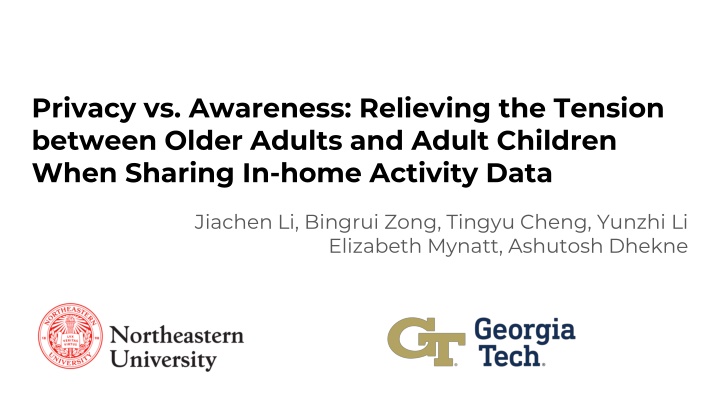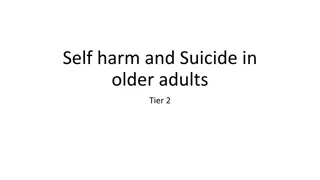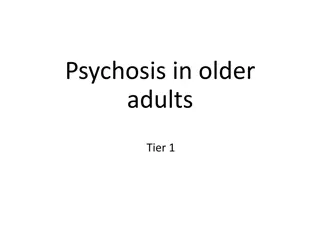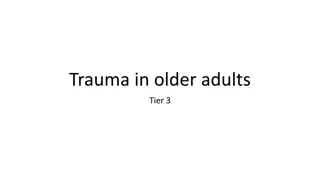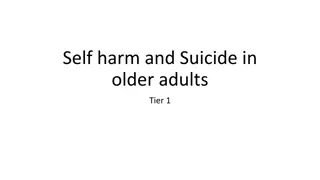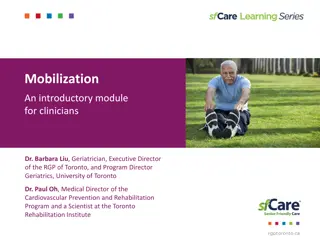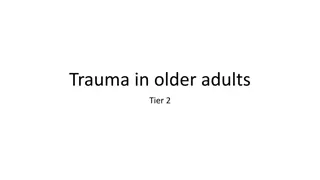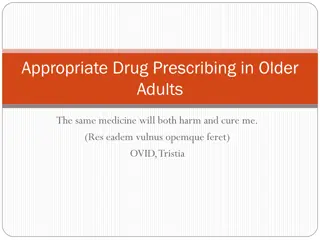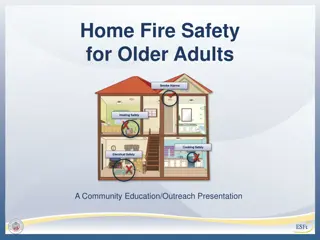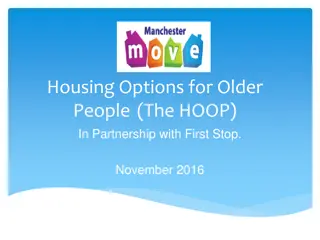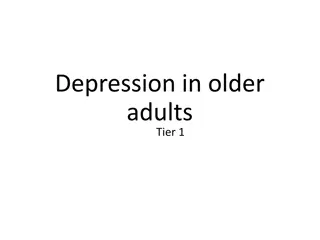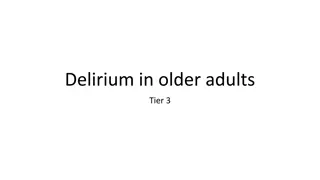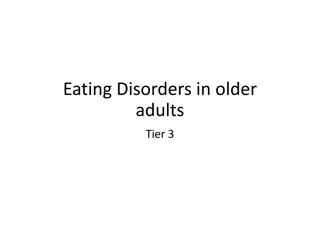Relieving Tension Between Older Adults and Adult Children
A study on the complex interplay of privacy and awareness when sharing in-home activity data between older adults and their adult children. With a focus on aging in place, the research delves into the dynamics, needs, and concerns of both parties, aiming to address safety, independence, and comfort. Insights from interviews, focus groups, and system development shed light on designing solutions that balance privacy with necessary information sharing and support low-level awareness for crucial daily activities.
Download Presentation

Please find below an Image/Link to download the presentation.
The content on the website is provided AS IS for your information and personal use only. It may not be sold, licensed, or shared on other websites without obtaining consent from the author.If you encounter any issues during the download, it is possible that the publisher has removed the file from their server.
You are allowed to download the files provided on this website for personal or commercial use, subject to the condition that they are used lawfully. All files are the property of their respective owners.
The content on the website is provided AS IS for your information and personal use only. It may not be sold, licensed, or shared on other websites without obtaining consent from the author.
E N D
Presentation Transcript
Privacy vs. Awareness: Relieving the Tension between Older Adults and Adult Children When Sharing In-home Activity Data Jiachen Li, Bingrui Zong, Tingyu Cheng, Yunzhi Li Elizabeth Mynatt, Ashutosh Dhekne
56 million people aged 65 and over lived in the United States The majority of older adults live in the community instead of nursing home or elder living facilities 90% of seniors express their willingness to stay in their own homes and community as they age 2
Aging in place The ability to live in one s own home and community safely, independently, and comfortably, regardless of age, income, or ability level. [1] [1] Centers for Disease Control, Prevention, et al. 2013. Public health terms for planners and planning terms for public health professionals. 3
I dont want to be monitored! Are my parents safe? power dynamics ? Adult children Older adult Privacy vs. Awareness 4
Interview & Focus group High-level takeaways 14 13 Elderly Children Initial design insights Designer Workshop 5 Researchers Designers System development iFloor Final design insights User testing 5 5 Elderly Children 6
High-level takeaways - Needs and Concerns Movement and Daily activities are important 14 daily activities crucial, private, casual, customized Only showing necessary information and avoiding any video data 7
4 Goals [2] High-level Takeaways Movement and daily activities Support low-level awareness Trends over time Respecting privacy concerns Crucial and customized activities Reduce complexity Private and casual activities Visual information [2] Elizabeth D Mynatt, Jim Rowan, Sarah Craighill, and Annie Jacobs. 2001. Digital family portraits: supporting peace of mind for extended family members. In Proceedings of the SIGCHI conference on Human factors in computing systems. 333 340. 10
Designer workshop 1-hour Prototyping Group Discussion Presentation Scenario Personas Storyboards 13
High-level takeaways Initial design insights Particular areas Support low-level awareness Movement and daily activities Avatar has different stages Highlight important status/activities Trends over time Visual cues -> time spent in an area Respecting privacy concerns Crucial and customized activities No private and casual activities Activity panels No visual information Only vague necessary furniture Reduce complexity 15 Ambient historical data
Initial design insights Particular areas Avatar has different stages Highlight important status/activities Visual cues -> time spent in an area Activity panels Only vague necessary furniture 17 Ambient historical data
Initial design insights Particular areas Avatar has different stages Highlight important status/activities Visual cues -> time spent in an area Activity panels Only vague necessary furniture 18 Ambient historical data
Initial design insights Particular areas Avatar has different stages Highlight important status/activities Visual cues -> time spent in an area Activity panels Only vague necessary furniture 19 Ambient historical data
User Testing - iFloor on the tradeoff spectrum Travelogue [3] iFloor video detailed abstract Day-in-fast- forward testing (30x) in a mock-up room Location -> Visualization (iFloor) 24 [3] Yunzhi Li, Tingyu Cheng, and Ashutosh Dhekne. 2022. Travelogue: Representing Indoor Trajectories as Informative Art. In Extended Abstracts of the 2022 CHI Conference on Human Factors in Computing Systems (New Orleans, LA, USA) (CHI EA 22). Association for Computing Machinery, New York, NY, USA, Article 387, 7 pages. https://doi.org/10. 1145/3491101.3519834
User Testing - iFloor on the tradeoff spectrum we show them.. Short fragment video of an activity Snapshot at a certain time we ask them.. Correctness What is Jasmine doing right now? Usefulness Do you think it s useful to get this video/visualization? Comfort level Will you feel comfortable sharing this to your children? 25
Correctness 26
Usefulness Comfort level 27
? More concrete -> More accurate and useful? Generally correct. ? More abstract -> More privacy preserved? Not really! 28
? Why abstract art is NOT the most privacy-preserved method? Distrust in technology Different level of tech literacy between older adults and children Cognitive impairment - > Declined learning ability Privacy Data privacy/security Perception of Privacy! 29
Discussion Awareness Safety alerts Disagreement regarding the level of autonomy of the elderly More trust in raw data resources 30
Initial design insights Final design insights Support low-level awareness Movement and daily activities Particular areas Avatar has different stages Highlight important status/accidents/activities Trends over time Visual cues -> time spent in an area Learning curve for non tech-savvy Respecting privacy concerns Crucial and customized activities Activity panels Design for Trust Align with original data resources A basic level of trust & understanding as the basis No private and casual activities Only vague necessary furnitures No visual information Reduce complexity Ambient historical data 31
(1) The design should convey relevant information about a persons daily life to support low-level awareness of that person s well-being. (a) Movement and daily activities (crucial and customized) (i) Particular areas should be created inside one room to highlight important activities (e.g.medication area). (ii) Avatar should have different visual effects to represent the person s real-time safety status. (iii) Important status/accidents/activities should be highlighted with evident and dynamic changes. (2) The design should depict trends over time or the different categories of information represented. (a) Use visual cues (e.g. color, size) to represent the time someone spends in certain areas. (3) The visualization should provide a qualitative view respecting privacy concerns. (a) Information of crucial and customized activities should be provided in a qualitative view. (i) Provide activity panels for crucial and customized activities (b) Information of private and casual activities should not be displayed. (i) Only include necessary furniture and make them vague. (c) No camera-based information should be captured and delivered. (4) Reduce the display s complexity. (a) History data is important, but make it ambient. (b) The learning curve of the qualitative view should be considered during the design process, especially for tech-unsavvy users. (5) Design for trust. (a) Display more information that is aligned with the original data resources to promote trust. (b) Provide enough information and explanation to make sure the user has a basic understanding of the graphics. (c) Keep in mind that a certain level of trust is the basis for users to share information without worrying about privacy issues. 34
Summary Privacy vs. Awareness tradeoff between older adults and their children when sharing in-home activities information Interviews and focus group sections + Designer workshop + User testing iFloor successfully balances the tradeoffs Abstract Comfortable to share with others -> Perception of privacy & Design for trust 35
Limitations Data collection in lab What if even indoor location is not okay? Female (80%) outnumber other gender identities 36
Khoury College Faculty Hiring - NEU Tenure Track and Research Active Teaching Faculty Resilient and Trustworthy Systems: Databases, Systems, Security and Privacy, Trustworthy AI, Quantum Next Generation Software: PL; Scalable Software; AI- assisted Programming Robotics and Foundations of AI: Foundations of ML, NLP, Computer Vision, Robotics Human-Centered AI and Embodied Intelligence: HCI, XR/AR/VR, Human-in-the-loop AI AI for Personal, Public, and Population Health: Digital Health, AI for health, Longitudinal and behavioral health Computer Science and Law: Data governance and privacy, Crypto and Law, Regulations and Generative AI Digital Civics: HCC, CSCW, ubicomp, visual analytics, smart cities, information ethics, public good tech Targeted support for post- doctoral researchers and early-career and senior faculty Hiring at Boston, San Jose, Mills/Oakland, Seattle and Arlington campuses
Support low-level awareness Thank You :) Movement and daily activities Particular areas Avatar has different stages @JasmineJiachenL Highlight important status/accidents/activities Trends over time Visual cues -> time spent in an area Respecting privacy concerns Crucial and customized activities Activity panels No private and casual activities Only vague necessary furniture No visual information Reduce complexity Ambient historical data Learning curve for non tech-savvy Design for Trust Align with original data resources 38 A basic level of trust & understanding as the basis
